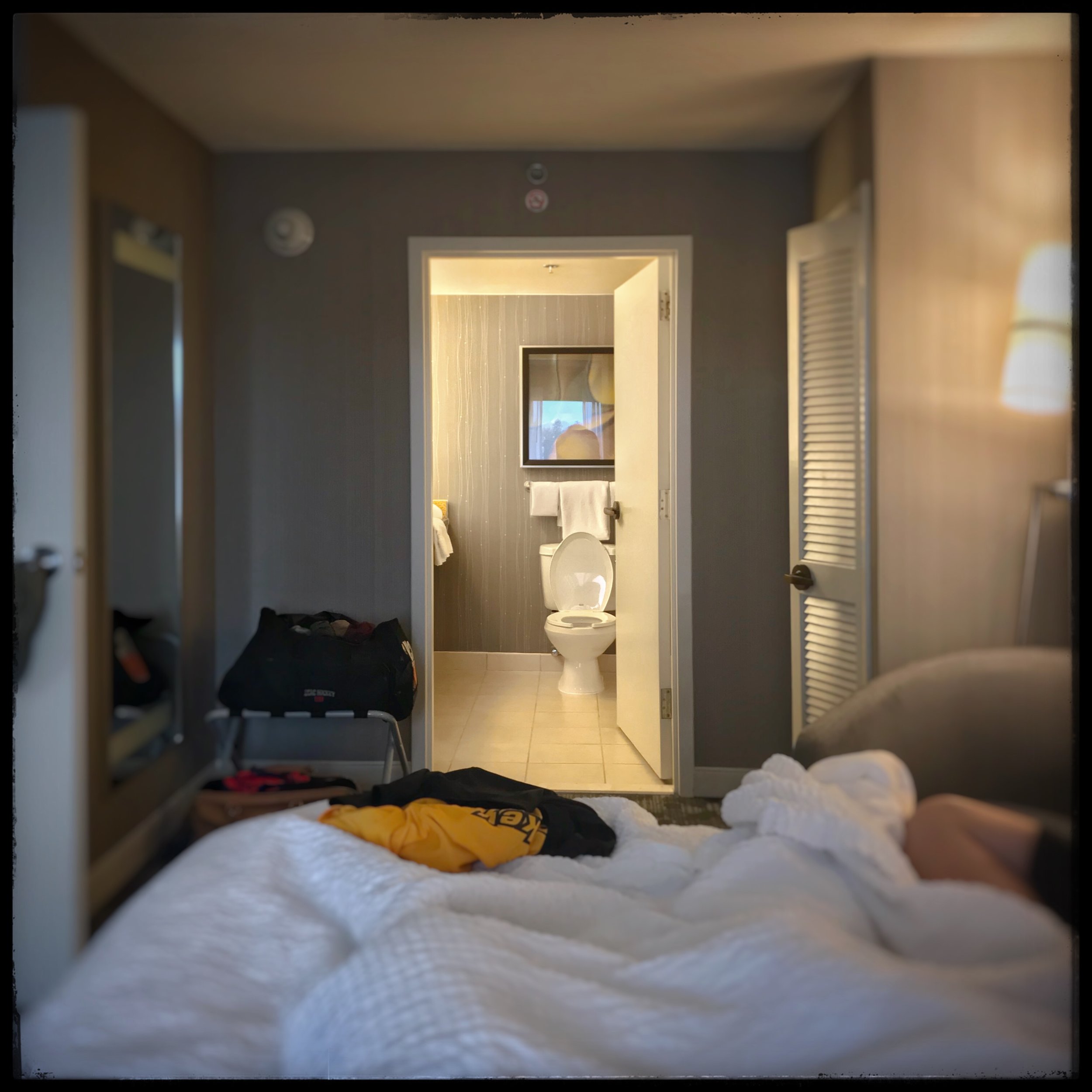blossoms ~ Bellerica, MA. (embiggenable) • iPhone
Spring was in full blossom in MA. over the weekend.
blossoms ~ Bellerica, MA. (embiggenable) • iPhone
Spring was in full blossom in MA. over the weekend.


hotel~ Billerica, MA • iPhone
On the road again for hockey. Will post more entries, this time from my iPad.
ocean lightning / Honorable Mention selection ~ South Jersey Shore (embiggenable) µ4/3
feet in situ ~ (embiggenable) • iPhone
I am finally back in the saddle after a 10 day hiatus which included a 3 day getaway, a 4 day hospital stay and a couple days of trying to feel like myself again. During that time, I received this notification:
I am very pleased to tell you that one of your images was selected for exhibition in our Middlebury, Vermont gallery. Congratulations! … I’d like to extend special congratulations to Juror’s Award recipient Kathleen Fischer and to Director’s Award recipient Atsuko Morita ... Congratulations also to three Honorable Mentions: Mark Hobson, Marilyn Maddison, and Kate Wnek.
I must admit that there is a degree of satisfaction which accompanies the fact that one of my pictures was selected for the exhibition, WATER, from amongst the nearly 3,000 submissions. Of the 35 pictures selected, it is also nice that my picture was called out with an Honorable Mention.
That written, I have previously written about the fact that, whoever the jurist(s) might be, their selections will be very subjective. My honorable mention picture might not even have made the cut into the exhibition with a different jurist on the case. And, to be honest, my honorable mention picture was a last minute addition to my 5 submissions and I did not consider it to be the pick of the litter. Lesson to be learned: one person's criteria is not another person's criteria.
In and event, re: the topic of criteria, I have been trying to adjust my criteria regarding the making of my pictures. That is, does a referent demanded a snapshot aesthetic approach or is it a "serious" picture making opportunity? And, perhaps more important, should I even care?
The primary consideration, re: "serious" v. snapshot designation, is that of which picture making tool to use in the making of a picture. "Serious" picture making would seem to call for a "serious" tool (aka: a "real" camera) whereas a snapshot not so much - in other words, a phone camera module. FYI, an aside ... I will confess that I feel that I am making a mountain out of a mole hill inasmuch as both tools produce very good image quality.
However, it's not the image quality I am concerned with. Rather, it is the picture making M.O. that I bring to the table when making a "serious" picture v a snapshot. To be precise, my "serious" picture making M.O. is oriented less to the referent and more to the visual structure-form v. content-of the picture. Whereas, in the case of a snapshot, I am much more oriented to the content than the form.
In addition to those considerations, I bring a more formal approach to "serious" picture making wheras with snapshot making I am more "loose" about framing and other technique notions. See the individual pictures in the feet in situ diptych above as an example.
What it all comes down to regarding determining whether a picture making opportunity calls for a "serious" or "loose" M.O. is that the tool I have in my hand actually does influence my picture making state of mind. A "real" camera in hand pushes me to a formal picture making mental state whereas an iPhone in my hand pushes me to a very "loose" picture making state of mind.

killing time • iPhone

hospital art • iPhone

re-gifted rose to me from the wife • iPhone
A crazy day in hospital so another entry created on iPhone with pictures made and processed with the iPhone. Posted from my hospital bed.
Kinda crazy when you think about it.

In hospital ‘til Thursday noon. This entry is a quickie from phone. Will post more from my laptop.
the sweeper ~ in the Adirondack PARK (embiggenable) • µ4/3
sweepings ~ in the Adirondack PARK (embiggenable) • µ4/3
sweepings awaiting picturing ~ in the Adirondack PARK (embiggenable) • µ4/3
Garry Winogrand stated:
Anything and all things are photographable. and Every photograph is a battle of form versus content.
Re: yesterday's entry, VANTAGE POINT / LEARNING HOW TO SEE, wherein I wrote about the field of visual energy, aka: form ... I believe that interesting / arresting form is what separates (very) good pictures from (merely) good pictures.
That is to write that interesting / arresting form is the characteristic which allows a print to become an object which, in and of itself, transcends that which it depicts. And, it interesting / arresting form which makes it possible to create very good pictures of any and all things.
tomatoes in strainer ~ in the Adirondack PARK (embiggenable) • iPhone
Excerpted from Szarkowski's quote, re: Vantage Point (as presented in yesterday's entry) ...
From his photographs, he learned that the appearance of the world was richer and less simple than his mind would have guessed.
As should be obvious to "serious" picture makers, there are many impressions / lessons to be gleaned from his/her pictures and, just as important, from pictures made by other picture makers. However, if one wishes to move beyond discerning the mere technical / technique properties to be noticed in a picture, one must develop and cultivate the capability to look beyond those properties and beyond whatever the picture depicts in order to see the print as an object in and of itself.
Garry Winogrand stated,"Photography is not about the thing photographed. It is about how that thing looks photographed." And, of course, the print is the evidence of how a "thing looks photographed".
The "thing" itself is experienced by the picture maker in a 3D world. In turn, the 3D "thing" itself is reduced to a 2D representation of that "thing" on the flat surface of a print. That 2D representation can then viewed as a collection of shapes, forms, lines, colors and tones-indepent of the depicted referent-which work/play together, within the frame imposed by the picture maker, to create what I refer to as a field of visual energy*.
iMo, it is the field of visual energy to be seen / experienced in a picture which stirs / stimulates the mind and soul / intellect and emotion of a viewer and it does so in a sensuous subconcsious / thoughtless manner ...
... Susan Sontage wrote that interpretation is the revenge of the intellect upon art. That interpretation-an overabundance of importance placed upon the content or meaning of an artwork-interferes with (or even negates) a viewer's ability to be keenly alert to the sensuous aspects of a given work.
All of that written, in my experience I have found that most "serious" picture makers' first impression upon viewing a picture (their own and those made by others) are focused upon: 1.) the referent, and 2.) the technical qualities of the picture's presentation. For the most part, they have never learned how to see the sensorial beauty that lies beyond the depicted obvious.
More's the pity inasmuch as, if a picture maker is oblivous to the unthought known hidden beneath the surface of a picture, he/she will never be able to let go of the intellect employed in the making of their own pictures and learn how to "feel it" when making / viewing pictures. Consequently, they will make pictures using the "rules" of composition in mind rather than finding a vantage point from which they can "arrange"-more by "feel" than thought-the visual elements of their 3D referent into a 2D sensual field of visual energy.
To close, 2 ideas expressed by Garry Winogrand:
A photograph is not what was photographed, it’s something else. and The photograph should be more interesting or more beautiful than what was photographed.*that field of visual energy can induce in a viewer a sense of serenity or, conversely, discordance.